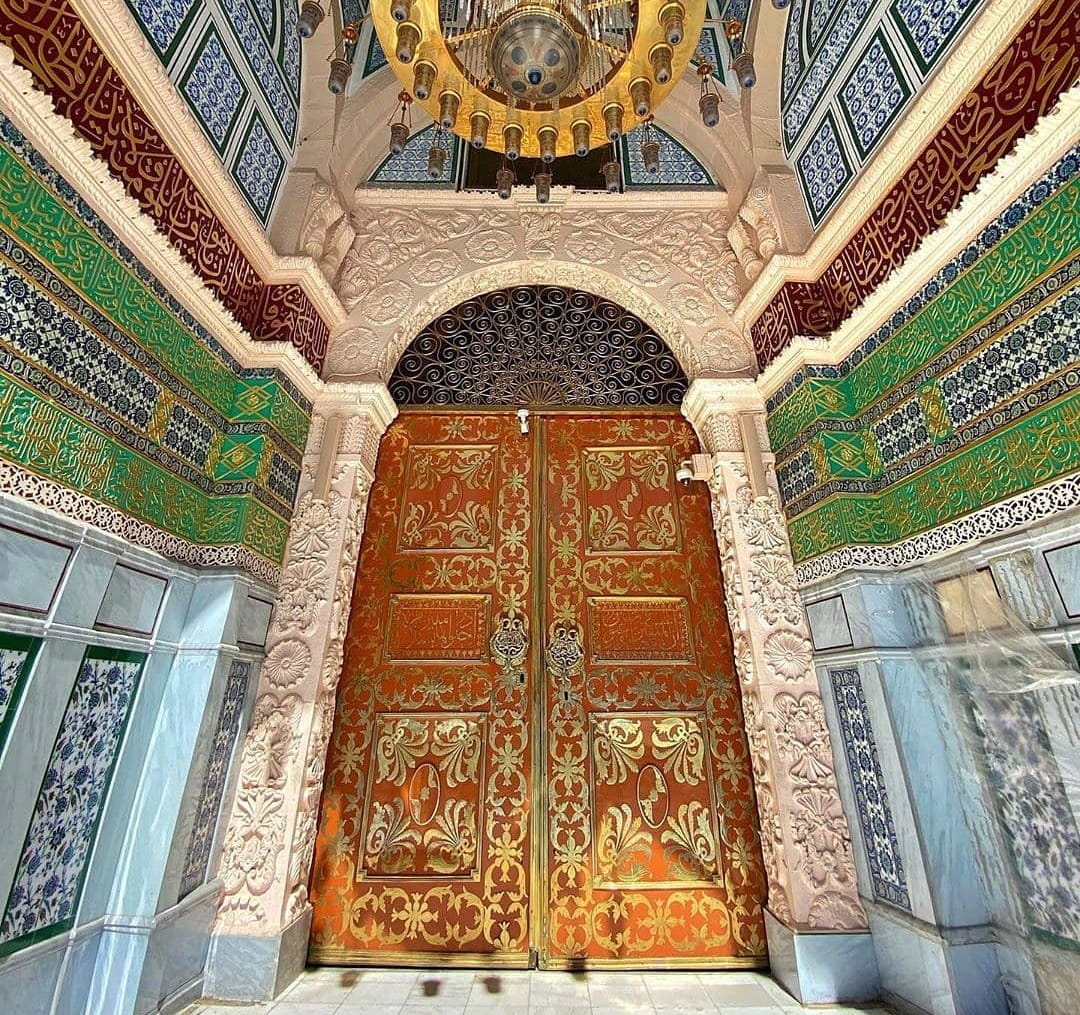In the heart of Madinah, Al Salam Gate (Bab as-Salam) stands as the most significant entrance to Masjid an-Nabawi, the Prophet’s Mosque. As Gate No. 1, it is not only the largest and most ornate of the mosque's 42 gates but also serves as the primary access point to the Rawdah, the sacred chamber housing the graves of Prophet Muhammad (ﷺ) and his companions. For pilgrims, entering through Al Salam Gate is a deeply spiritual experience, symbolizing peace and reverence.
For many pilgrims arriving in Madinah—often using the convenient Hop-On Hop-Off Bus, which stops at major religious and historic landmarks—Al Salam Gate marks the beginning of a deeply emotional and reverent experience. Crossing this threshold is more than entering a building; it’s stepping into centuries of legacy, prayer, and peace.
Historical Significance of Al Salam Gate
Origins and Evolution
Constructed in 640 CE (18 AH) during the caliphate of Umar ibn al-Khattab, Al Salam Gate was originally part of the mosque's western wall. Over the centuries, it has been relocated westward during various expansions, maintaining its alignment with the original structure. Despite these changes, it remains one of the oldest and most revered gates of Masjid un-Nabawi.
Architectural Features
Al Salam Gate (Bab as-Salam) is not just a passageway—it’s a work of art, a statement of reverence, and an architectural legacy that reflects the evolving beauty of Masjid-e-Nabawi across centuries. Here's a closer look at what makes it so iconic.
1. Grand Ottoman Design Influence
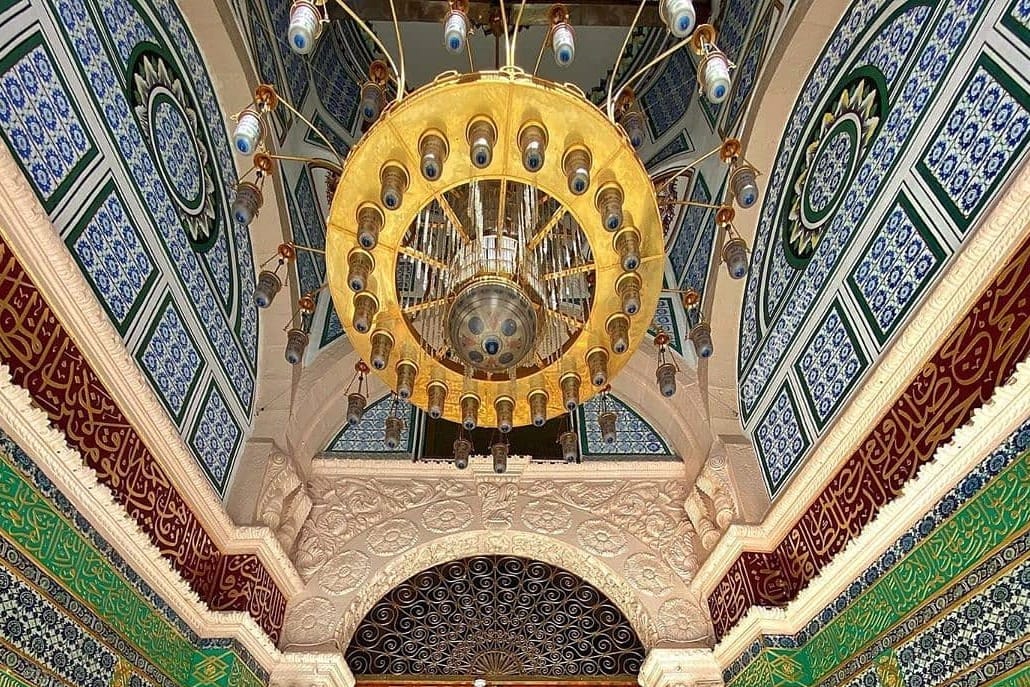
The current gate structure owes much of its elegance to Ottoman-era architecture, particularly the renovations carried out under Sultan Abdul Majid Khan in 1855 CE (1271 AH). Key elements include:
- Symmetrical layout with balance between form and function
- Heavy use of geometric and floral motifs in stone carvings
- Incorporation of Iznik tile-inspired patterns in decorative details
These stylistic choices were meant to inspire awe and reflect the grandeur of the space one is about to enter.
2. Arched Entry and Cascading Arches
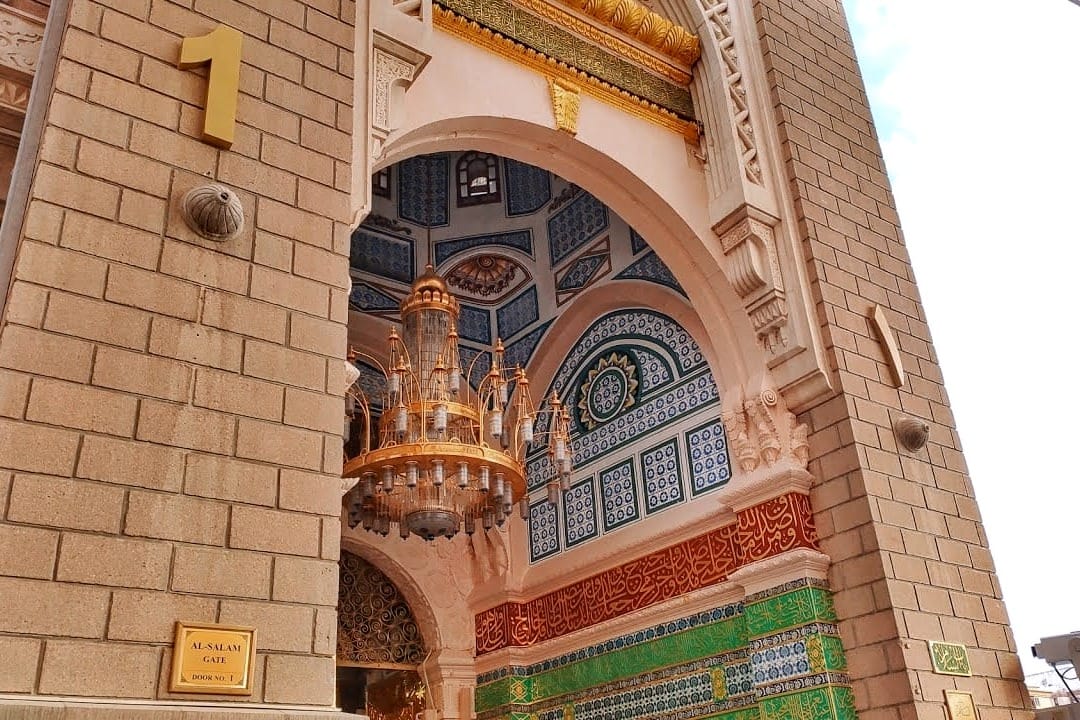
The gate features a dominant central arch, flanked by cascading smaller arches—a hallmark of Islamic architecture symbolizing openness and unity. These arches frame the gate beautifully and give it a rhythmic, inviting presence.
- The main arch is larger than typical gate entries in the mosque
- Cascading arches are layered to give depth and elegance
- The pattern leads the eye upward, creating a visual sense of elevation
3. Quranic Calligraphy and Sacred Inscriptions
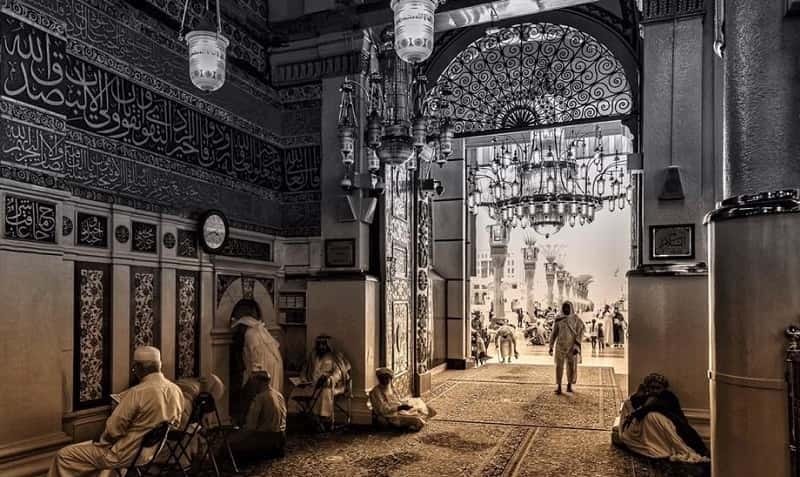
One of the most spiritually uplifting features of Al Salam Gate is the intricate calligraphy that adorns the interior arch and surrounding panels.
- Verses from the Qur’an engraved in elegant Thuluth script
- Names of Allah and the Prophet Muhammad (ﷺ) artistically woven into decorative elements
- Reflective inscriptions designed to prepare the heart for the sanctity beyond the gate
4. Minaret Above the Gate
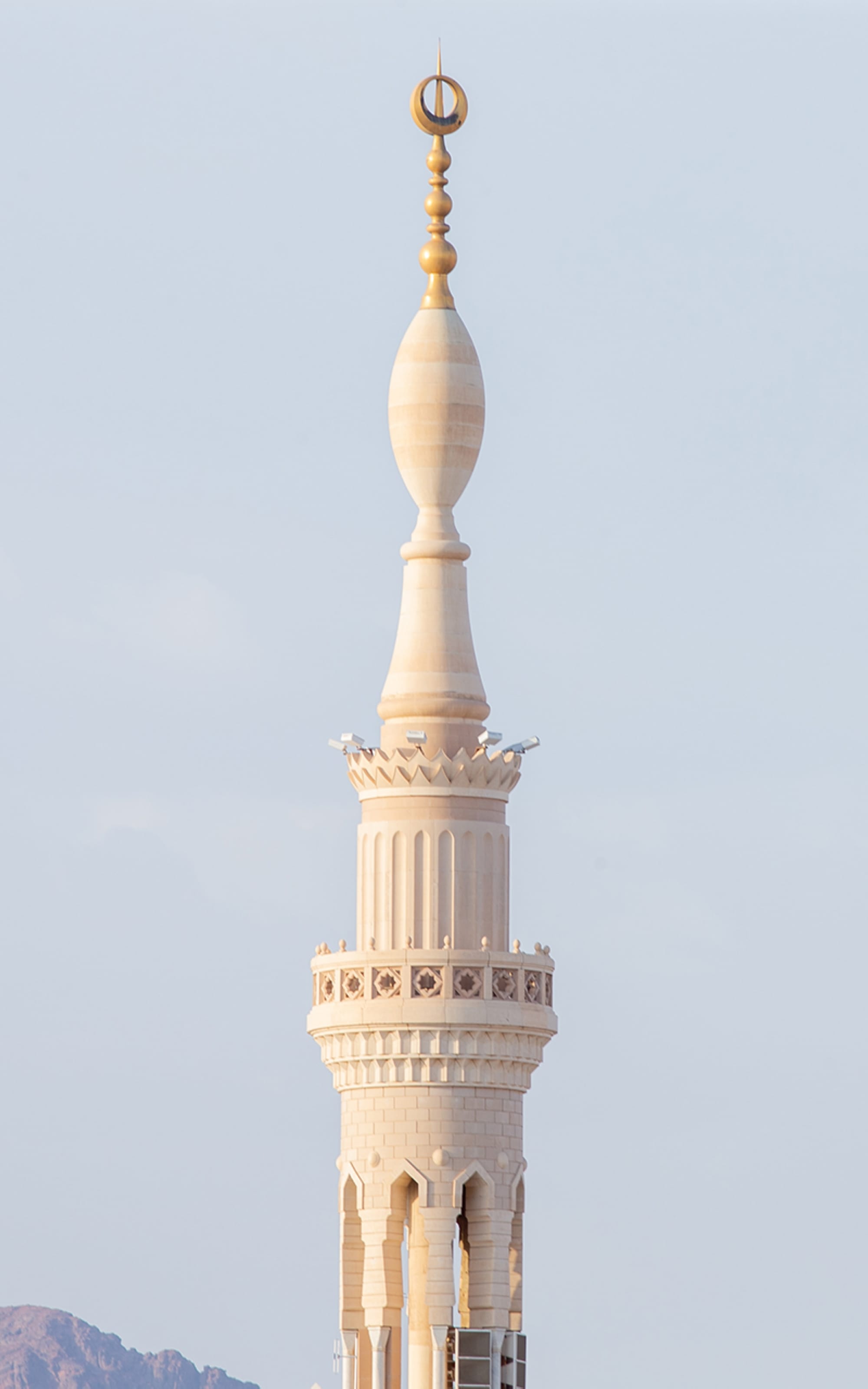
Al Salam Gate is topped with a distinctive minaret, which not only serves as a visual marker but also adds vertical grandeur to the gate’s silhouette.
- The minaret was added during one of the Ottoman renovations
- It serves as a traditional symbol of spiritual elevation
- It is aligned with the western façade, acting as a guidepost for pilgrims approaching from that direction
5. Historic Wooden Doors
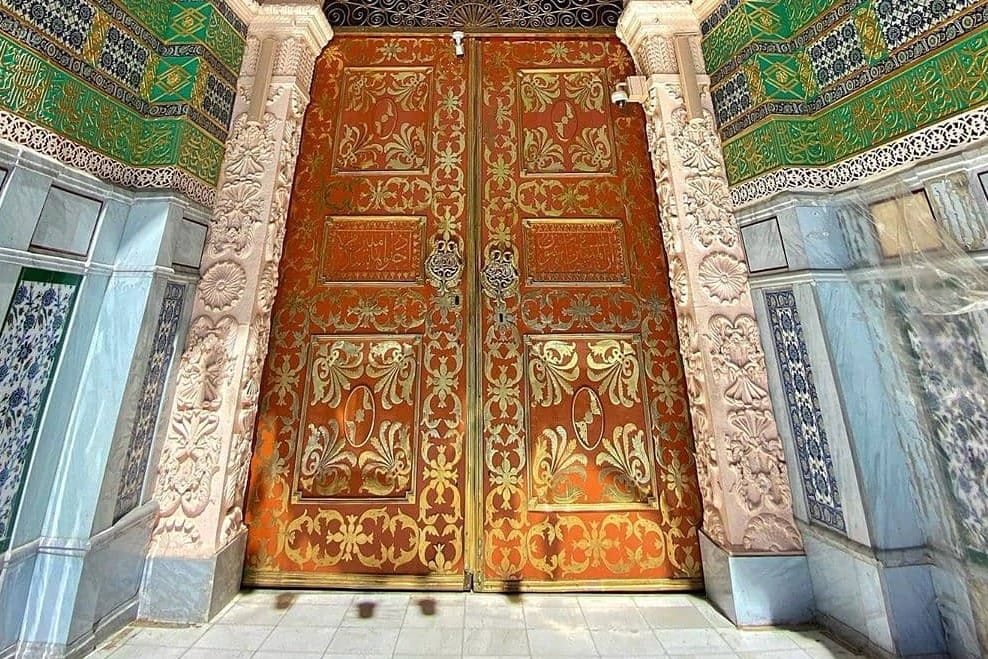
The gate's heavy wooden panels, originally installed in 1855 CE (1271 AH), still retain elements of their original Ottoman craftsmanship:
- Bronze studs and gilded motifs reinforce both strength and artistry
- Woodwork features arabesque designs, showcasing centuries-old techniques
- These doors symbolize the passage from the outer world into a sacred zone of peace and reflection
Spiritual Importance of Salam Gate
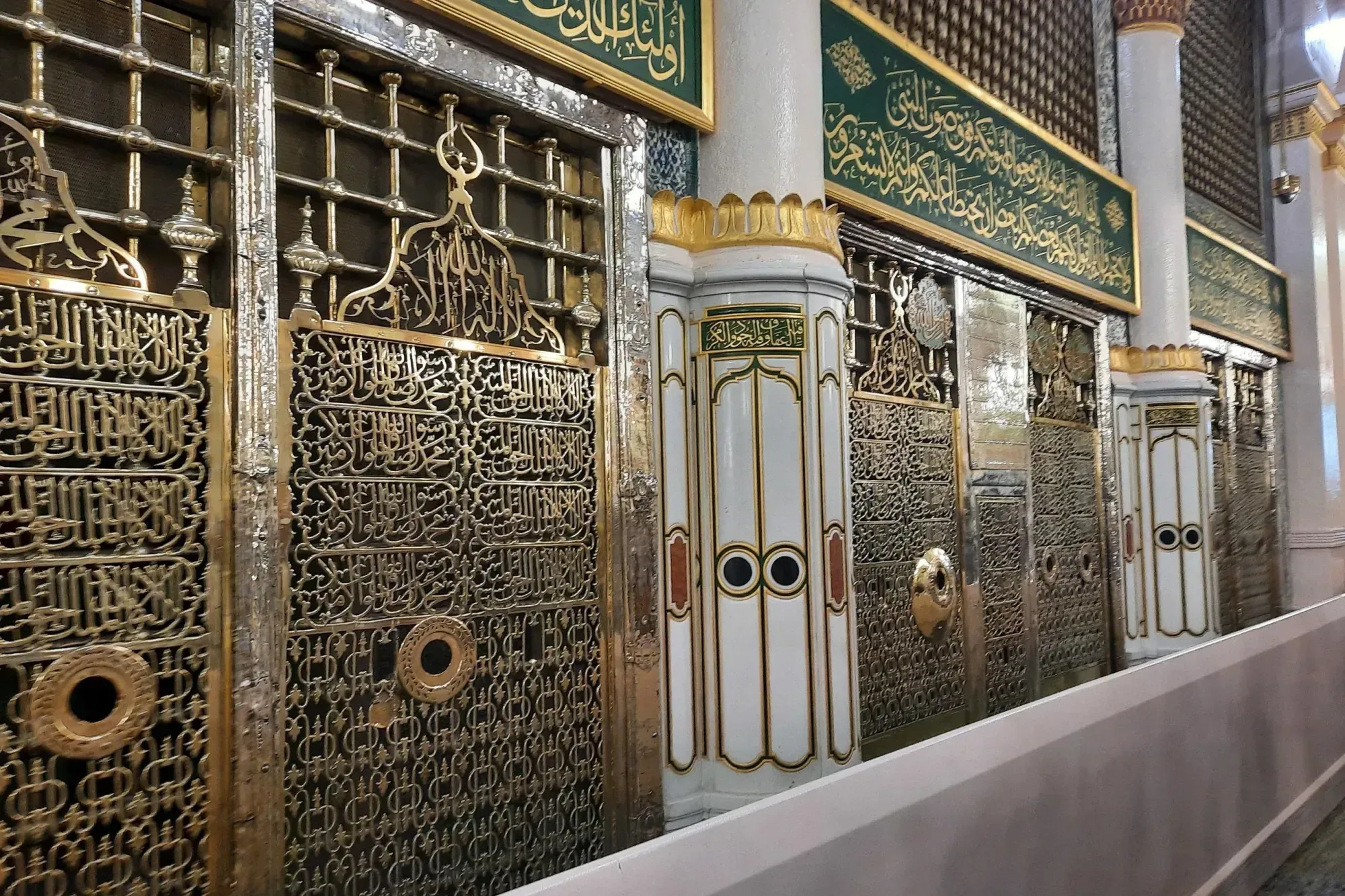
Direct Access to the Rawdah
Al Salam Gate provides direct access to the Rawdah, also known as Riyazul Jannah or the Garden of Paradise. This sacred area lies between the Prophet's tomb and his pulpit (minbar) and is considered one of the most revered spaces in Islam. The Prophet Muhammad (ﷺ) said;
"What is between my house and my pulpit is one of the gardens of Paradise."
What’s Inside the Rawdah
Within the Rawdah, lies the Sacred Chamber—a space revered by millions as the final resting place of three of the most significant figures in Islamic history. The chamber is enclosed by a beautifully designed golden grille, which features three distinct viewing holes, each aligned with one of the graves.
Prophet Muhammad (ﷺ)
The beloved Prophet of Islam is buried in the room of his wife Aisha (RA), where he passed away. This intimate space became his final resting place, and it now stands as the spiritual heart of Masjid un-Nabawi.
Abu Bakr al-Siddiq (RA)
The first Caliph of Islam, and one of the Prophet’s closest companions, Abu Bakr (RA) was laid to rest beside the Prophet Muhammad (ﷺ) . His unwavering leadership and love for the Prophet made his burial in this sacred space a profound honor.
Umar ibn al-Khattab (RA)
The second Caliph of Islam, Umar (RA) was granted permission by Aisha (RA) to be buried beside his companions. After being fatally wounded, he requested to be laid to rest in the Sacred Chamber—his wish was fulfilled, completing this blessed trio.
Practical Information for Visitors
Navigating the Mosque
- Location: Western side of Masjid an-Nabawi.
- Gate Number: 1.
- Nearest Underground Parking: Areas 2A and 2B.
- Access: Provides direct entry to the Rawdah and the Prophet's tomb.
Enhancing Your Visit: Hop-On Hop-Off Bus
Exploring Madinah's ziyarat sites can be both enriching and seamless with the Hop-On Hop-Off Bus Tour—a top choice for pilgrims seeking comfort, convenience, and meaningful context during their journey.
Why It's Ideal for Visiting Rawdah via Al Salam Gate
The Hop-On Hop-Off Bus includes a dedicated stop at Al Salam Gate (Gate No. 1), making it one of the easiest and most direct ways to reach the Rawdah Mubarak—especially for first-time visitors or those unfamiliar with the mosque’s layout.
- Direct Stop at Al Salam Gate – Step off the bus just a short walk away from the entrance that leads directly to the Prophet’s Chamber and Rawdah.
- Simplifies Your Itinerary – Avoid the stress of navigating crowded roads or finding parking near Masjid an-Nabawi.
- Multi-language Audio Guides – Learn about Madinah’s spiritual and historical landmarks as you travel.
What to Expect from the Experience
- 12 Curated Stops: Including key sites like:
- Al Baqi Cemetery
- Quba Mosque
- Qiblatain Mosque
- Flexible Schedule:
- Operates daily from early morning until late evening
- Buses run every 30 minutes, allowing you to explore at your own pace
- Comfortable Seating & Air Conditioning: Ideal for families, elderly visitors, and those performing Umrah or Ziyarat in warm weather
Pro Tip for Pilgrims
If you're planning to visit the Rawdah, aim to board the bus early in the day to align with Rawdah visitation slots. This ensures you have time to enter through Al Salam Gate and offer your prayers in peace—without rushing.
To enter the Rawdah Mubarak, all visitors must book an appointment through the official Nusuk App. Walk-ins are not permitted, even if you enter via Al Salam Gate.
Conclusion
Al Salam Gate is more than just an entrance; it's a portal to a profound spiritual journey. Its historical roots, architectural beauty, and direct access to the Prophet's tomb make it the most important gate of Masjid un-Nabawi. For pilgrims and visitors alike, entering through Al Salam Gate is an experience imbued with reverence, peace, and a deep connection to Islamic heritage.
May the peace you felt at Al Salam Gate accompany you long after you leave Madinah. Until your next blessed visit!

